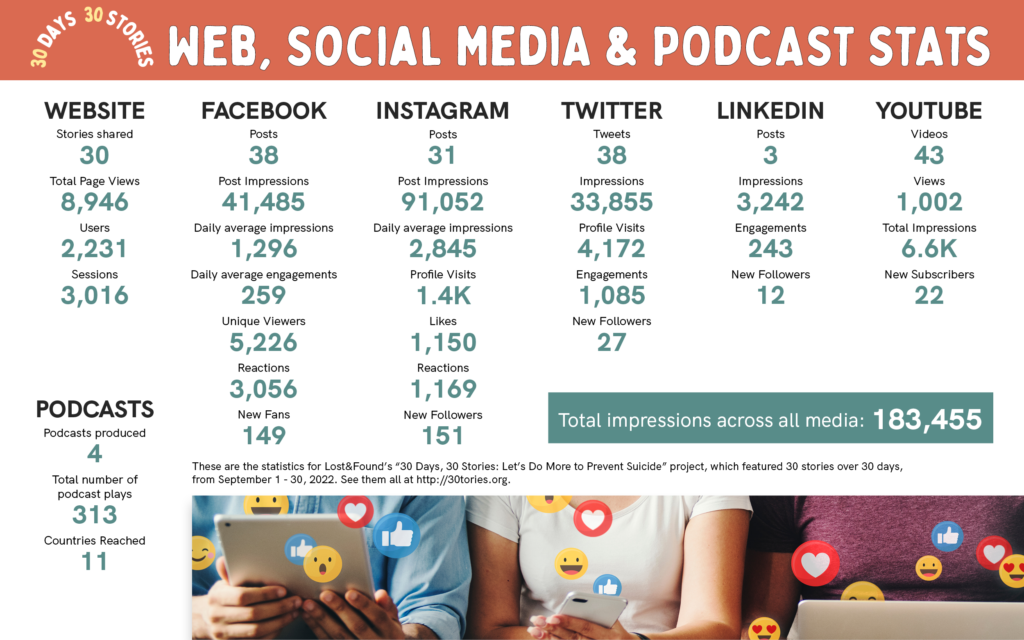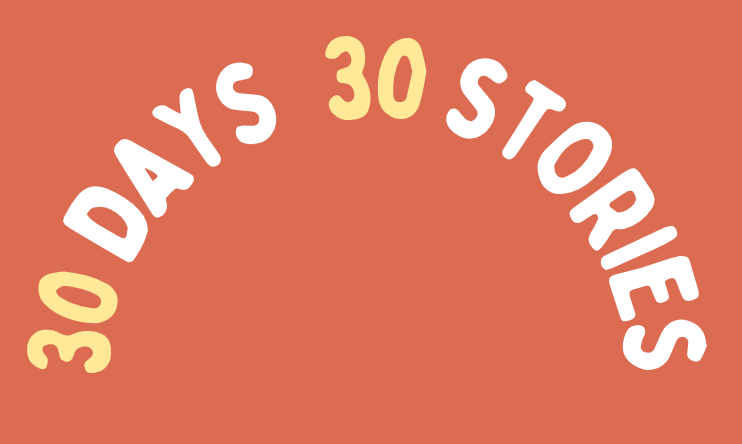What we learned from the #30Days30Stories project in 2022
Thirty storytellers shared their stories of struggles with mental health and how they are finding resilience as part of Lost&Found’s 30 Days, 30 Stories project, which was part of National Suicide Prevention Month in September. Here, we reflect on what we learned from the project.
1. Finding storytellers was easier than it was in our first year, but challenges remain.
- From staff members and partners in the mental health profession, we were able to come up with a list of more than 50 names of potential storytellers. “People are waiting to tell their stories; we just have to ask them to do so,” said L&F Community Engagement Manager Joel Kaskinen. “In our second year of this campaign, I found it easier to find people to share their stories, which tells me our communities are more open to sharing and the stigma around mental illness and suicide is decreasing.”
- While getting stories, photos, and videos from about 20 storytellers from our list of potential storytellers was fairly straightforward, finding the last 10 was more difficult. Some potential storytellers didn’t feel it was the right time to tell their stories. Five people submitted stories, but we were unable to follow up to schedule photos with them. “Recruiting seemed rushed at the end,” said Prevention Programming Specialist Melissa Renes. “I would suggest offering the opportunity year-round and making it more normalized to share instead of requesting stories later in the year.”
2. We made improvements in recruiting stories that represent the diversity in our communities.
“I think the attempt to find diverse stories helped show that we were inclusive, and that mental health does not discriminate,” Renes said. “It put faces to the work we are doing.”
- One significant improvement was telling more stories from the LGBTQIA2S+ community. More than 30 percent of storytellers indicated they are something other than heterosexual (including “prefer not to disclose”). This is important, because surveys (such as this one from the Trevor Project) indicate that LGBTQIA2S+ individuals are at higher risk for suicide. Telling these stories empowers the storytellers and helps to foster understanding empathy and understanding in the rest of society.
- Our storyteller demographics in terms of race were not yet representative of the state as a whole or of the demographics of suicide in South Dakota. Native Americans make up 8.5 percent of South Dakota residents, and 20 percent of suicides in South Dakota (2012-21) were of Native Americans; just 1, or 3 percent, of our storytellers was Native. We had stories from three additional Native Americans but were unable to connect with them for photos and videos, which suggests we need to work on our process to accommodate people who might have difficulty traveling or taking off from work to meet us for a photo shoot. We hope to be able to connect with some or all of those storytellers for next year’s project.
- We didn’t have as many stories as we’d hoped from people in our target age group. Sixty percent were in the target age group of 10-34. Forty percent of our storytellers were 35 to 54. We definitely value stories of resilience from people of any age, but it would be nice to have more stories from people who are in our target demographic.
- While we improved in our gender balance from last year, 70 percent of our storytellers were women. “Young women are the most willing to share their stories,” Kaskinen said. “Women aged 10-34 was also the demographic that we reached most through social media.” We will continue to work to break through the limiting “tough guy” stereotype that men can’t talk about their mental health.
3. Storytellers gave a wide variety of resources that helped them find resilience.
“The resources showcased emphasized that when looking at recovery and maintaining positive mental health, there is not a one-size-fits-all approach,” Renes said. The categories of resources suggested were professional mental health care (31 percent), family and friends (20 percent), other strategies (20 percent), support groups (14 percent), educational resources (10 percent) and crisis resources (4 percent). (Most storytellers cited more than one resource.)
- Storytellers cited professional mental health care (in a variety of forms) most often when they listed resources that had helped them. While it’s wonderful that people have found help through professional services, this makes it that much more important to try to get more people into the mental health profession. There are not enough people to meet the need currently.
4. Storytellers shared a message of hope: It is possible to improve mental health.
- The path from a dark place to a better place varies greatly from person to person, but it often starts with communication. This communication can come from person struggling: Speaking up about what is going on with them, connecting with a resource, or asking for help. But storytellers often welcomed the care of a friend or family member to start the conversation, and they wished more people had voiced their care and concern. “A theme I noticed throughout stories was that people wished more had talked to them, or they would have liked to know more resources were there,” Renes said.
The project had an impressive 183,455 impressions across all media! Here are some additional statistics on the reach of the project through the web, social media, and the Great Minds with Lost&Found podcast:


